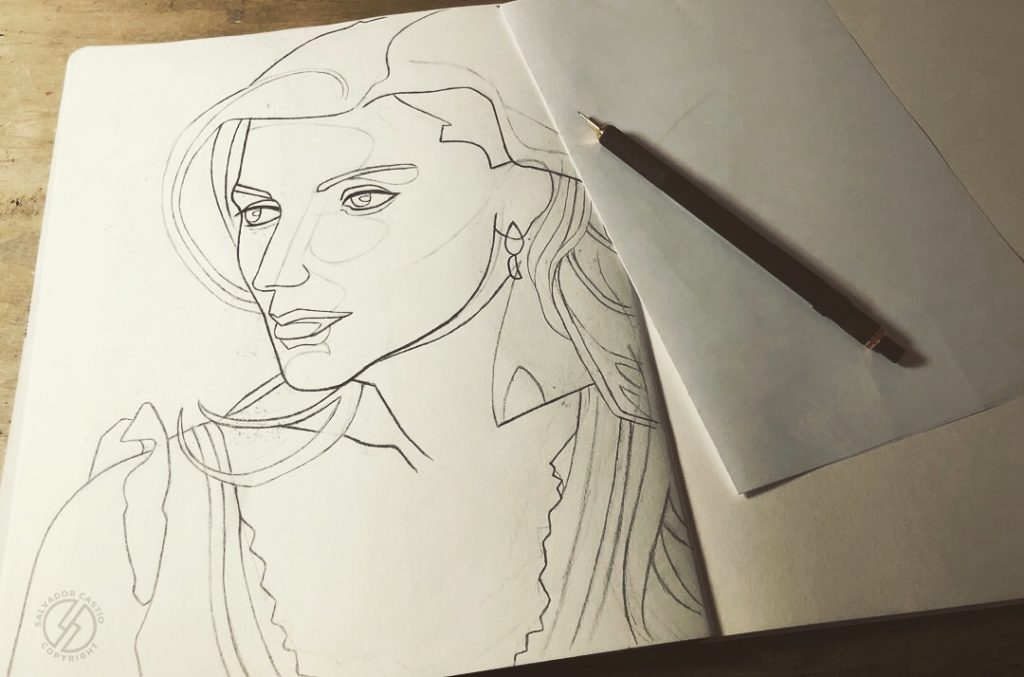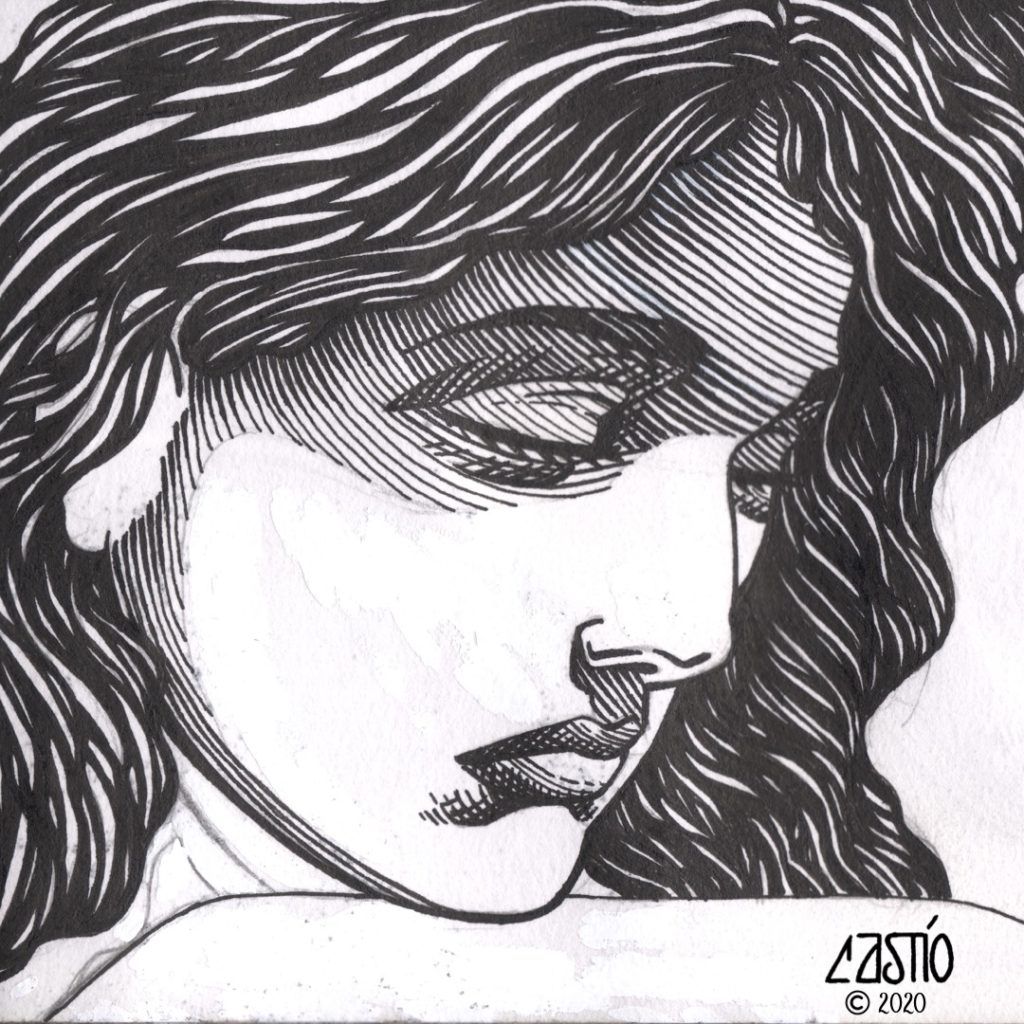Dr. Nina Ansary (Preliminary Drawing). Sketchbook.
I became a professional artist at the age of 25. At that point, I had some knowledge and a somewhat refined set of skills, but I had a long way to go before those things were truly polished and honed to the high degree that they are now. Five years of art school did wonders for me, but, truth be told, it was just a beginning. Of all the things that I learned during my years at Parsons School of Design and the Academy of Art College, there was one that was sadly missing: dealing with the general public. Such a class would have softened the blow to the system that happens when you start dealing with the GP. Instead, I had to learn that the hard way. Beyond all the erroneous ideas and misconceptions about art that exist within the GP there’s one thing that has stood out more than anything else: the trivialization and the under valuing of what I, and other professionals do. This became apparent to me right from the get-go, and it’s something that hasn’t changed over the years. Sadly, it’s probably gotten worse.
As a young professional, you want people to like your work and you want to get paid decently for your efforts. Because of this, you back yourself into a corner that the GP loves to exploit. If there’s one thing the GP loves more than cheap art, it’s free art. To add insult to injury, the GP assumes some sense of knowledge about what it takes to make art. These fine folks will commission you and then art direct a project straight into the ground with all their bad ideas. This nonsense is what folks like me have to put up with all the time. It’s also why I have stopped taking commissions. On rare occasions I may consider making an exception to this rule, if it gives me the freedom I need and pays me what I’m worth. You think I’m making this up? I couldn’t make these things up even if I tried. At this point I’ve heard it all and then some. The variety of erroneous ideas and misconceptions about making art held by the GP is truly breathtaking. No matter how crass people can be when it comes to art, nothing compares to the nonstop attempts to trivialize what people like me do on a daily basis. Years ago I was asked to draw a portrait for someone’s birthday. The person who was interested in commissioning me was a friend, so I waived the fifty percent fee I normally charge up front and assumed things would go as planned. Two weeks later, when I had completed the work, I was met with a plea of, “I couldn’t get all the money – can I pay you as soon as I get paid next week?” That week never came, and, in the end, I never saw one single cent for my efforts. The GP has no shame whatsoever in doing such things. The bottom line here is that, according to the general public art should always be cheap if not free.
I guess the one thing that I’ve learned over the years that’s spoken loudest to me is the fact that people are hypocrites when it comes to the visual arts. On the one hand they don’t believe that making art requires any real special skill. In the GP’s eyes art is something that everyone and anyone can do. No special talent or knowledge required. Before someone gets their knickers in a twist about what I just said, please allow me to clarify. I’m talking about professional level work here, not stuff that’s done by folks as a hobby or as a cathartic release. I’m fine with those things – they are, however, not what I am addressing here. What I’m talking about here is something that has existed as long as people like me have made art. A good example about what I’m getting at here is something that underground comix legend Robert Crumb has talked about. Until the age of 25 he had been pretty much blown off by most people. Nobody cared about what he did or how well he did it. Then in 1968, he drew the first issue of the seminal title, ZAP Comix, which made him a counterculture icon overnight. Crumb has often talked about how crazy his life became after his work began attracting attention. Everybody wanted to be his best friend; everybody wanted to invite him to their parties or to dinner. All the women who had shunned him suddenly wanted to sleep with him. Fame and money changed everything for him. They validated him as a “Real Artist,” in the GP’s eyes. Before that he was just another loser: nothing special. It’s this blatant dichotomy that’s hard to overlook. One day you’re a nobody doing work that anyone could do and the next you’re the toast of the town – a brilliant artist all of a sudden (as if you weren’t before). The GP always wants to have its cake and eat it too.
After years of putting up with this kind of crap, you do one of the following: 1. call it a day and get yourself a dead-end cubicle job and cruise on down to 65, 2. swallow your pride, sell your soul, and start creating vapid art that caters to the bad taste and bad ideas of the general public, or 3. you come to your senses, take the bull by the horns, and proclaim yourself to be an artist that isn’t going to play the bullshit game that some expect you to play. We all get one go around in this thing we call life. We all decide what we truly want and its level of priority to us. Some people want to fly to the moon; some people want to be movie stars; some people want to sit in a cubicle eight hours a day until they reach 65, etc. My lot in life is to make art. I’ve known that since I was 5 years old and I have never ever contemplated doing anything else. I started like a lot of folks: with a dream and a desire. From an early age I knew that I had the potential to be great. As the years went by it started to become clear to me that fulfilling my potential was going to take decades of hard work. It’s what’s called playing the long game. Most people don’t have any idea about that because the idea of someone spending decades to perfect something is psychotic to them. Most folks will never be interested in playing the long game for one reason: there’s no instant gratification involved. We live in an age where we want everything by yesterday. We want to click a button and download it right now, we want it on demand 24/7. The notion of everything by yesterday doesn’t work when it comes to playing the long game. Truly great things take time: great skill, great work, etc. If you stick it out long enough you’ll eventually reap the rewards.
This is not something unique to me. Other people have also traveled a similar road. They too have invested blood, sweat, and tears into what they do. I refrain from using cliche terms like “Paying your dues,” because they fail to give an accurate picture of all the effort that a person has invested into becoming the very best at what they do. Despite everything I’ve been through, the crass and uninformed comments hurled at me over the years have served a purpose: they’ve forced me to make a clear and informed decision about what I want for myself. I’m acutely aware of the fact that you get one shot at what you want in life, so you can bet your bottom dollar that I’m going to do things my way. I’m not here to impress anyone or to collect accolades unless they’re from my peers. I do what I do to satisfy myself and no one else. I’m not easily dazzled and I’m very picky about the people I hang around with. I like to be around people who will challenge and pushed into making better work. If any of what I’ve written here comes across as arrogant don’t worry, I’m fine with that. Frank Lloyd Wright used to say that you can choose between honest arrogance or hypocritical humility. My choice is clear. Great things take time, especially great work. I value what I’ve worked for and it’s for this very reason that what I do will always be expensive.


